黄梅英文介绍ppt
- 格式:ppt
- 大小:8.18 MB
- 文档页数:25
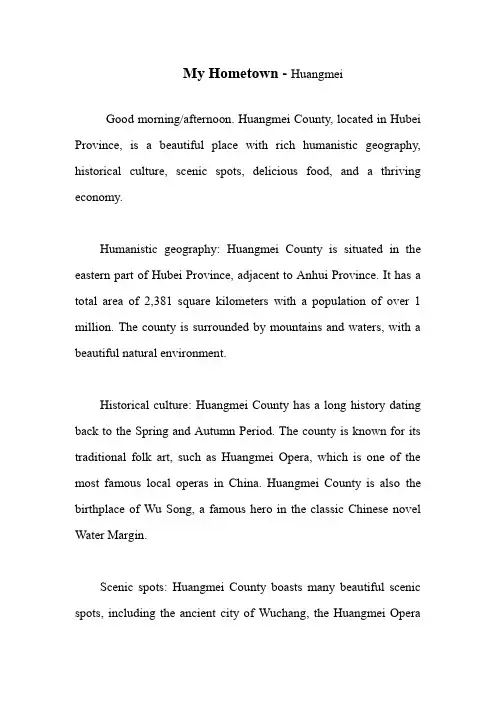
My Hometown -HuangmeiGood morning/afternoon. Huangmei County, located in Hubei Province, is a beautiful place with rich humanistic geography, historical culture, scenic spots, delicious food, and a thriving economy.Humanistic geography: Huangmei County is situated in the eastern part of Hubei Province, adjacent to Anhui Province. It has a total area of 2,381 square kilometers with a population of over 1 million. The county is surrounded by mountains and waters, with a beautiful natural environment.Historical culture: Huangmei County has a long history dating back to the Spring and Autumn Period. The county is known for its traditional folk art, such as Huangmei Opera, which is one of the most famous local operas in China. Huangmei County is also the birthplace of Wu Song, a famous hero in the classic Chinese novel Water Margin.Scenic spots: Huangmei County boasts many beautiful scenic spots, including the ancient city of Wuchang, the Huangmei OperaMuseum, the Wulongtan Scenic Area, and the Qixingyan Scenic Area. These attractions showcase the county's rich history and culture, as well as its stunning natural beauty.Delicious food: Huangmei County is known for its delicious local cuisine, such as Huangmei salted fish, Huangmei tofu, and Huangmei braised pork. These dishes are famous for their unique flavors and cooking methods, and are popular among both locals and tourists.Economy: Huangmei County has a thriving economy with a focus on agriculture and tourism. The county is rich in natural resources, such as bamboo, tea, and fish, which provide abundant raw materials for local industries. The tourism industry is also booming, with many visitors coming to explore the county's beautiful scenery and rich cultural heritage.In summary, Huangmei County is a wonderful place with a rich history, beautiful scenery, delicious food, and a thriving economy. It is a great destination for anyone looking to experience the best of Hubei Province. That's all for my introduction of Huangmei. If you have any questions about my hometown, feel free to ask me. Thankyou!。
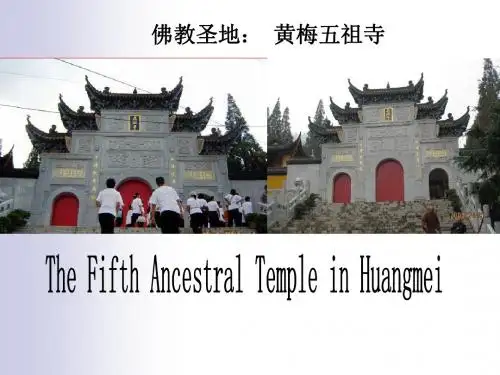
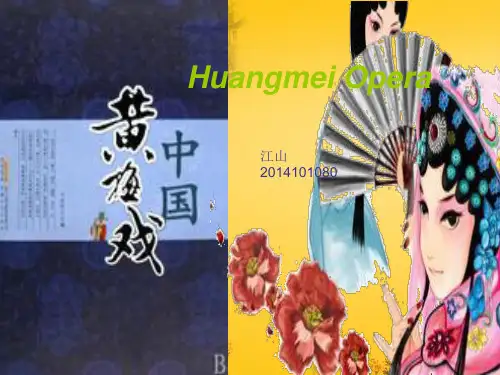
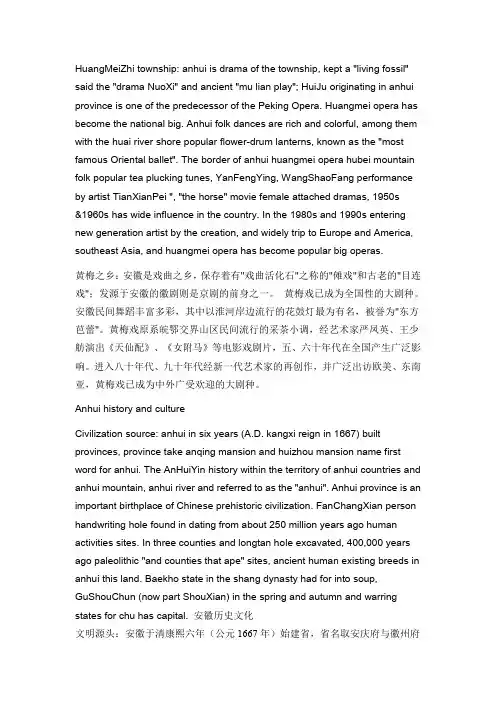
HuangMeiZhi township: anhui is drama of the township, kept a "living fossil" said the "drama NuoXi" and ancient "mu lian play"; HuiJu originating in anhui province is one of the predecessor of the Peking Opera. Huangmei opera has become the national big. Anhui folk dances are rich and colorful, among them with the huai river shore popular flower-drum lanterns, known as the "most famous Oriental ballet". The border of anhui huangmei opera hubei mountain folk popular tea plucking tunes, YanFengYing, WangShaoFang performance by artist TianXianPei ", "the horse" movie female attached dramas, 1950s&1960s has wide influence in the country. In the 1980s and 1990s entering new generation artist by the creation, and widely trip to Europe and America, southeast Asia, and huangmei opera has become popular big operas.黄梅之乡:安徽是戏曲之乡,保存着有"戏曲活化石"之称的"傩戏"和古老的"目连戏";发源于安徽的徽剧则是京剧的前身之一。
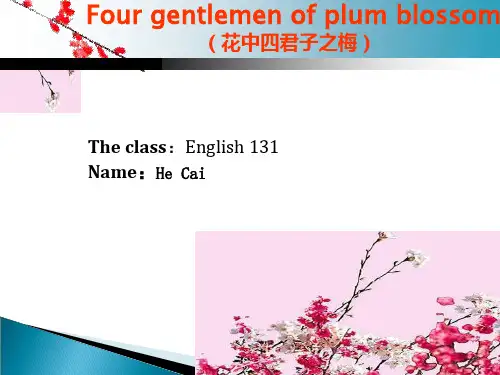
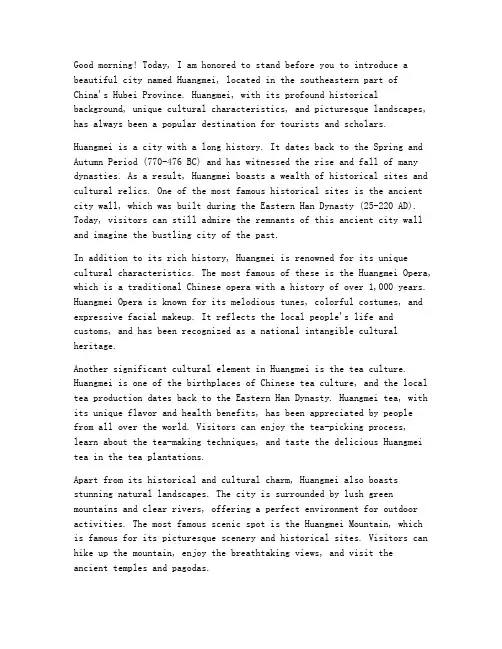
Good morning! Today, I am honored to stand before you to introduce a beautiful city named Huangmei, located in the southeastern part ofChina's Hubei Province. Huangmei, with its profound historical background, unique cultural characteristics, and picturesque landscapes, has always been a popular destination for tourists and scholars.Huangmei is a city with a long history. It dates back to the Spring and Autumn Period (770-476 BC) and has witnessed the rise and fall of many dynasties. As a result, Huangmei boasts a wealth of historical sites and cultural relics. One of the most famous historical sites is the ancient city wall, which was built during the Eastern Han Dynasty (25-220 AD). Today, visitors can still admire the remnants of this ancient city wall and imagine the bustling city of the past.In addition to its rich history, Huangmei is renowned for its unique cultural characteristics. The most famous of these is the Huangmei Opera, which is a traditional Chinese opera with a history of over 1,000 years. Huangmei Opera is known for its melodious tunes, colorful costumes, and expressive facial makeup. It reflects the local people's life and customs, and has been recognized as a national intangible cultural heritage.Another significant cultural element in Huangmei is the tea culture. Huangmei is one of the birthplaces of Chinese tea culture, and the local tea production dates back to the Eastern Han Dynasty. Huangmei tea, with its unique flavor and health benefits, has been appreciated by people from all over the world. Visitors can enjoy the tea-picking process, learn about the tea-making techniques, and taste the delicious Huangmei tea in the tea plantations.Apart from its historical and cultural charm, Huangmei also boasts stunning natural landscapes. The city is surrounded by lush green mountains and clear rivers, offering a perfect environment for outdoor activities. The most famous scenic spot is the Huangmei Mountain, which is famous for its picturesque scenery and historical sites. Visitors can hike up the mountain, enjoy the breathtaking views, and visit theancient temples and pagodas.In recent years, Huangmei has become a popular tourist destination for both domestic and international travelers. The city government has invested heavily in the development of tourism, improving infrastructure, and promoting cultural and historical sites. As a result, Huangmei has attracted numerous tourists who are eager to explore its rich cultural heritage and enjoy the beautiful landscapes.In conclusion, Huangmei is a city that combines the beauty of nature,the charm of history, and the richness of culture. Whether you are interested in exploring ancient cities, immersing yourself intraditional Chinese opera, or enjoying the picturesque scenery, Huangmei is the perfect destination for you. I believe that after visiting Huangmei, you will fall in love with this magical city and its unique charm.Thank you for your attention!。
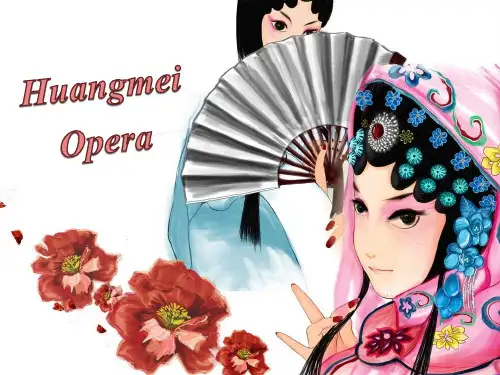
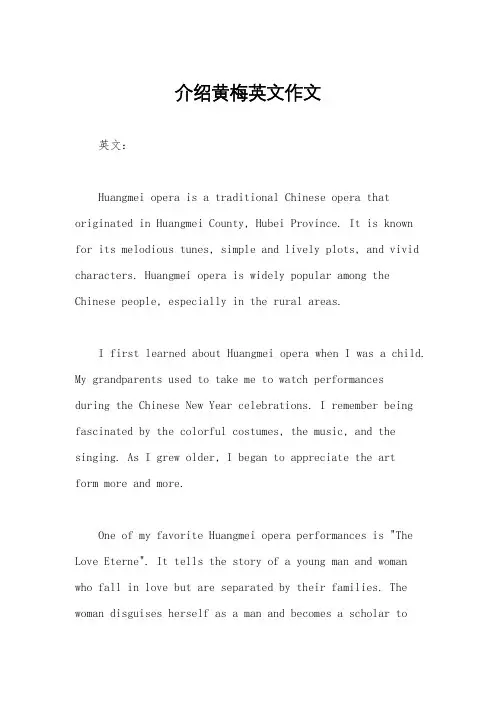
介绍黄梅英文作文英文:Huangmei opera is a traditional Chinese opera that originated in Huangmei County, Hubei Province. It is known for its melodious tunes, simple and lively plots, and vivid characters. Huangmei opera is widely popular among the Chinese people, especially in the rural areas.I first learned about Huangmei opera when I was a child. My grandparents used to take me to watch performancesduring the Chinese New Year celebrations. I remember being fascinated by the colorful costumes, the music, and the singing. As I grew older, I began to appreciate the artform more and more.One of my favorite Huangmei opera performances is "The Love Eterne". It tells the story of a young man and woman who fall in love but are separated by their families. The woman disguises herself as a man and becomes a scholar tobe near her lover. The story is both romantic and tragic, and the music is beautiful.Another thing I love about Huangmei opera is the way it incorporates folk songs and dances. The performers often interact with the audience, encouraging them to sing along and dance along. It creates a sense of community and joythat is hard to find in other forms of entertainment.中文:黄梅戏是起源于湖北省黄梅县的传统戏曲。
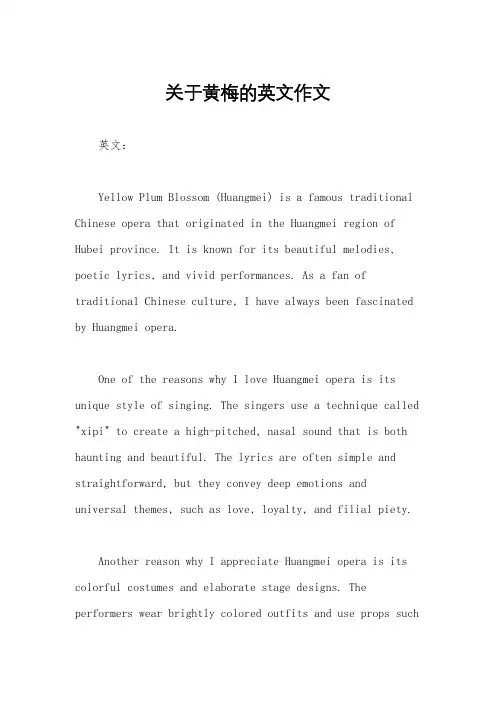
关于黄梅的英文作文英文:Yellow Plum Blossom (Huangmei) is a famous traditional Chinese opera that originated in the Huangmei region of Hubei province. It is known for its beautiful melodies, poetic lyrics, and vivid performances. As a fan of traditional Chinese culture, I have always been fascinated by Huangmei opera.One of the reasons why I love Huangmei opera is its unique style of singing. The singers use a technique called "xipi" to create a high-pitched, nasal sound that is both haunting and beautiful. The lyrics are often simple and straightforward, but they convey deep emotions and universal themes, such as love, loyalty, and filial piety.Another reason why I appreciate Huangmei opera is its colorful costumes and elaborate stage designs. The performers wear brightly colored outfits and use props suchas fans, umbrellas, and swords to enhance their movements and expressions. The stage is often decorated withintricate backdrops and lighting effects, creating amagical and immersive atmosphere.中文:黄梅戏是一种著名的中国传统戏曲,起源于湖北省的黄梅地区。
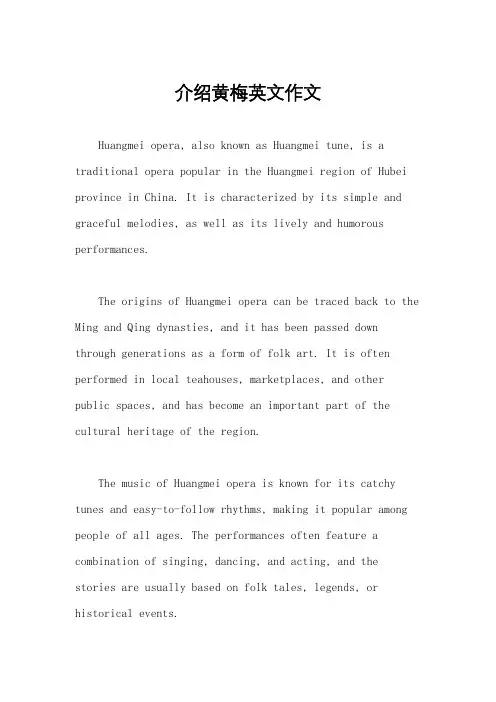
介绍黄梅英文作文Huangmei opera, also known as Huangmei tune, is a traditional opera popular in the Huangmei region of Hubei province in China. It is characterized by its simple and graceful melodies, as well as its lively and humorous performances.The origins of Huangmei opera can be traced back to the Ming and Qing dynasties, and it has been passed down through generations as a form of folk art. It is often performed in local teahouses, marketplaces, and other public spaces, and has become an important part of the cultural heritage of the region.The music of Huangmei opera is known for its catchy tunes and easy-to-follow rhythms, making it popular among people of all ages. The performances often feature a combination of singing, dancing, and acting, and thestories are usually based on folk tales, legends, or historical events.One of the most famous Huangmei opera songs is "The Wandering Songstress", which tells the story of a young woman who travels the countryside, singing and entertaining people with her beautiful voice. The song has been widely popularized through various adaptations in film and television, and has become a symbol of Huangmei opera.In recent years, efforts have been made to preserve and promote Huangmei opera as a cultural heritage. Various performances, competitions, and festivals have been organized to showcase the art form and attract more people to appreciate and participate in it.Overall, Huangmei opera is a unique and vibrant form of traditional Chinese opera that continues to thrive in the modern era. Its lively performances, catchy tunes, and rich cultural heritage make it a valuable asset to the cultural landscape of China.。
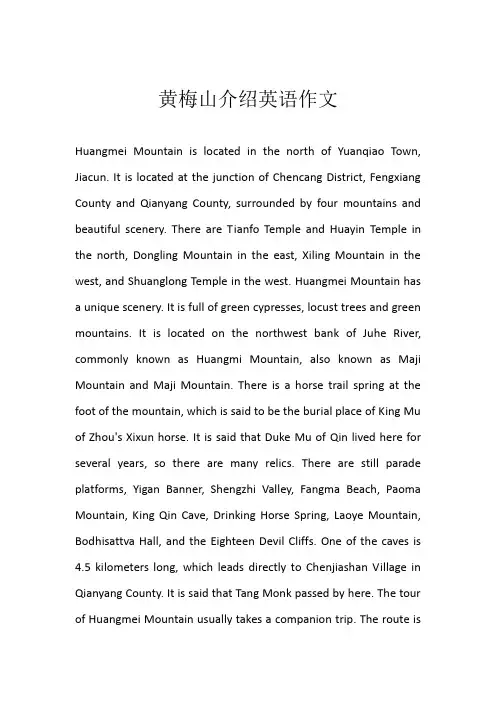
黄梅山介绍英语作文Huangmei Mountain is located in the north of Yuanqiao Town, Jiacun. It is located at the junction of Chencang District, Fengxiang County and Qianyang County, surrounded by four mountains and beautiful scenery. There are Tianfo Temple and Huayin Temple in the north, Dongling Mountain in the east, Xiling Mountain in the west, and Shuanglong Temple in the west. Huangmei Mountain has a unique scenery. It is full of green cypresses, locust trees and green mountains. It is located on the northwest bank of Juhe River, commonly known as Huangmi Mountain, also known as Maji Mountain and Maji Mountain. There is a horse trail spring at the foot of the mountain, which is said to be the burial place of King Mu of Zhou's Xixun horse. It is said that Duke Mu of Qin lived here for several years, so there are many relics. There are still parade platforms, Yigan Banner, Shengzhi Valley, Fangma Beach, Paoma Mountain, King Qin Cave, Drinking Horse Spring, Laoye Mountain, Bodhisattva Hall, and the Eighteen Devil Cliffs. One of the caves is 4.5 kilometers long, which leads directly to Chenjiashan Village in Qianyang County. It is said that Tang Monk passed by here. The tour of Huangmei Mountain usually takes a companion trip. The route isgenerally along the plateau of Jia Village, passing Panlong, Jia Village, and Qiaozhen. You can drive to the foot of Beiwan Village, go up the mountain from Yaoyazui, and walk about an hour from Tianfo Temple to Huangmei Mountain. The initial path up the mountain is steep and zigzag shaped, with thorns and rocks blocking it from time to time. When you get to this mountain, you can see a series of terraced sloping tablelands, which are separated by ravines. There are no concentrated villages and scattered farmers. Look around: Fengjiashan Reservoir Dam in the east is magnificent; In the south of the Second Power Plant and Dongling Lead Zinc Plant, the smoke is misty; Jiacun tableland in the west is vast and boundless; Huangmei Mountain in the north stands in the sky. At the foot of the mountain, on the Baoji Zhongyuan railway line, a series of passenger cars flew by. The Huangmei Mountain range, initially in a north-south direction, may be blocked by thousands of rivers. It is east-west in the north and south-north after turning a big bay. It stretches for several miles, just like a giant python lying between heaven and earth, hazy, cloud covered, powerful and mysterious.。
I know that America’s national flower is rose, is it? Do you know what is China’s national flower? Plum blossom is evaluated as the number one of the Chinese Top Ten Famous Flowers. And it is also China’s national flower. Chinese plant culture has its unique national features which differ from those of other nations. Today I’d like to explain to you why plum blossom is very important to our Chinese people according to its history and culture connotation.I’d like to begin with its history. Plum blossom was originated in the south of China around the Yangtze River dating back to 7000 year ago during the Neolithic Age. From ancient China to modern China, plum blossom has been planted not only as an important kind of commercial crop but also a kind of ornamental plant. Later it was introduced to Japan, Korea and Vietnam.More importantly, we love plum blossom also because of its deep culture connotation. Firstly, this kind of flower has five petals which symbolize happiness, good luck, longevity, smooth sailing and peace. Secondly, when a whirling snow obscures the sky and all other flowers wither and fall, only plum trees stand upright proudly and bloom in rich colors bringing people the news of early spring. Therefore the plum blossom came to symbolize courage, perseverance and hope, but also beauty, purity, and the new life. In Confucianism, the plum blossom stands for the principles and values of virtue. Because it blossoms in the cold winter, the plum blossom is regarded as one of the "Three Friends of Winter", along with pine, and bamboo. It is also regarded as one of the "Four Gentlemen" of flowers in Chinese art together with the orchid, chrysanthemum, and bamboo. Thirdly, it plays an important role in Chinese literature. It has been frequently depicted in Chinese poetry and art for centuries. An example of the plum blossom's literary significance is found in "Little Plum Blossom of Hill Garden" by Lin Bu of the Song Dynasty.In conclusion, because of its long history and deep cultural connotation, plum blossom is very important to Chinese people.When everything has faded they alone shine forth,encroaching on the charms of smaller gardens.Their scattered shadows fall lightly on clear water,their subtle scent pervades the moonlit dusk.Snowbirds look again before they land,butterflies would faint if they but knew.Thankfully I can flirt in whispered verse,I don't need a sounding board or wine cup.Jiya SunGroup: BlueSpeech Class - TT 12:30pmPlum BlossomIntroduction: talk about America’s national flower; than China’s national flowerThesis: Plum blossom is very important to Chinese peopleForecast: history and culture connotationBody:1.History:(1)origin- 7000years ago, Yangtze River(2)Be introduced to Japan, Korea and Vietnam2.Culture Connotation(1)The symbolic meanings of five petalsHappiness, good luck, longevity, smooth sailing and peace(2)The symbolic meanings of plum blossoma. Reasons: bloom in winterb. Meanings: courage, perseverance, hope, beauty, purity, thenew lifeEg. In Confucianism, the principles and values of virtue "Three Friends of Winter" and "Four Gentlemen" of flowers(3) Role in literatureEg: "Little Plum Blossom of Hill Garden"Conclusion:Because of its long history and deep cultural connotation, plum blossom is very important to Chinese people.Bibliography1. Long M.Z. A Bird’s-Eye View of Chinese Culture. East China University Press.2009-5-12. Sun Y. Chinese Culture in Plant. China Fulihui Press.2009-10-13. Wang Y.B. China Encyclopedia. Xian Zhuang Books Press. 2002-09(注:文档可能无法思考全面,请浏览后下载,供参考。